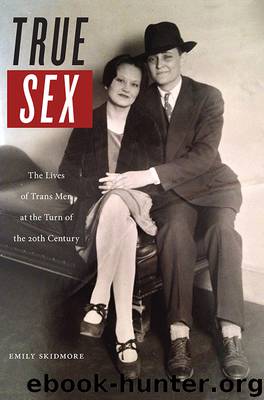True Sex: The Lives of Trans Men at the Turn of the Twentieth Century by Emily Skidmore

Author:Emily Skidmore
Language: eng
Format: epub
Tags: History, United States, 20th Century, Women
Publisher: NYU Press
Published: 2017-09-19T01:03:05.550000+00:00
Conclusion
As this chapter has shown, newspapers throughout the early twentieth century found that foreignness was a convenient means to pathologize nonnormative gender and sexual formations. Foreignness provided a framework for national newspapers to produce gender transgressions as wholly un-American. Queer embodiment in and of itself was not enough for newspapers to interpret one’s presence as a threat. Rather, the threat was determined by the perceived combination of gender, race, nation, and sexuality—with race and nation playing a bigger role than gender and sexuality well into the twentieth century.
Perceptions of one’s body were by no means stable, and were deeply dependent on the local and global sociopolitical context. For example, Jack Garland’s queer body was produced in the national press as an asset to the nation while he pledged his allegiance to the imperial project of the Philippine-American War; however, he was seen as a potential threat to the nation in the midst of World War I, when his queer body elicited suspicion that he might be a German spy. This dramatic shift illustrates the precarious position in which trans men found themselves: their gender variance rendered them susceptible to suspicion, and they had to constantly prove their trustworthiness to their communities. As the response to Jack Garland and Ralph Kerwineo illustrates, local communities were willing to be persuaded of their queer neighbors acceptability, provided those neighbors could prove their allegiance to the nation or show a history of respect for the institution of marriage and/or heteronormativity. However, once the stories circulated beyond the local context, both individuals were treated less as community members than as threats to the community. The structure of familiarity was stripped away, and both stories were distilled down to binaries that suggested the individuals in question were dangerous, deviant, and un-American. The distinction between the local and national narratives in these cases suggests how precarious the survival of trans men of color was in the early twentieth century—how easy it was for newspaper editors to erase their voices and replace their carefully constructed explanations with tropes of belonging that rendered them deviant outsiders because of their purported foreignness.
Of course, it was all the more possible for newspaper editors to erase the voices of trans men after their death: even the local papers cast Nicolai De Raylan and Peter Stratford as deviant outsiders. The stories of De Raylan, a Russian immigrant with purported connections to revolutionary activities in his home country, and Peter Stratford, a New Zealand immigrant with connections to the Islamic sect of Sufism, were distilled to stories in which their gender deviance was connected to their “foreign” identity. Their supposed “masquerade” as men was produced as the primary example of how they could not be trusted and could never be part of their communities because they were essentially, and at their core, outsiders. These stories are, therefore, powerful reminders of the power of whiteness and national belonging in rendering queerness unexceptional, another benefit in the long list of privileges white individuals enjoy but historians seldom acknowledge.
Download
This site does not store any files on its server. We only index and link to content provided by other sites. Please contact the content providers to delete copyright contents if any and email us, we'll remove relevant links or contents immediately.
| African-American Studies | Asian American Studies |
| Disabled | Ethnic Studies |
| Hispanic American Studies | LGBT |
| Minority Studies | Native American Studies |
Cecilia; Or, Memoirs of an Heiress — Volume 1 by Fanny Burney(31447)
Cecilia; Or, Memoirs of an Heiress — Volume 3 by Fanny Burney(31037)
Cecilia; Or, Memoirs of an Heiress — Volume 2 by Fanny Burney(30985)
The Great Music City by Andrea Baker(23036)
We're Going to Need More Wine by Gabrielle Union(18127)
Bombshells: Glamour Girls of a Lifetime by Sullivan Steve(13159)
Pimp by Iceberg Slim(13000)
All the Missing Girls by Megan Miranda(12841)
Fifty Shades Freed by E L James(12492)
Talking to Strangers by Malcolm Gladwell(11991)
Norse Mythology by Gaiman Neil(11964)
Crazy Rich Asians by Kevin Kwan(8413)
Mindhunter: Inside the FBI's Elite Serial Crime Unit by John E. Douglas & Mark Olshaker(7899)
The Lost Art of Listening by Michael P. Nichols(6534)
Enlightenment Now: The Case for Reason, Science, Humanism, and Progress by Steven Pinker(6449)
Bad Blood by John Carreyrou(5816)
The Four Agreements by Don Miguel Ruiz(5578)
Weapons of Math Destruction by Cathy O'Neil(5097)
We Need to Talk by Celeste Headlee(4922)
